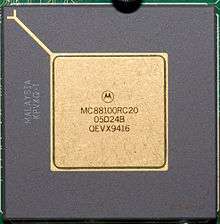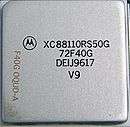Motorola 88000
The 88000 (m88k for short) is a RISC instruction set architecture (ISA) developed by Motorola during the 1980s. The MC88100 arrived on the market in 1988, some two years after the competing SPARC and MIPS. Due to the late start and extensive delays releasing the second-generation MC88110, the m88k achieved very limited success outside of the MVME platform and embedded controller environments. When Motorola joined the AIM alliance in 1991 to develop the PowerPC, further development of the 88000 ended.
| Designer | Motorola |
|---|---|
| Bits | 32-bit |
| Introduced | 1988 |
| Design | RISC |
| Type | Register-Register |
| Encoding | Fixed |
| Branching | Compare and branch |
| Endianness | Bi |
| Extensions | Graphics instructions (88110 only) |
| Open | No |
| Registers | |
| General purpose | 32 32-bit |
| Floating point | 32 80-bit (88110 only) |
History
Originally called the 78000 as a homage to their successful 68000 series, the design went through a tortuous development path, including the number change, before finally emerging in April 1988.
The initial version, the MC88100, generally required a separate MMU, the MC88200. The MC88200 added both MMU and data and instruction caches. By this time most processors had an MMU built-in, including Motorola's own 68030, and returning to a separate MMU chip was a step backward. The MC88100/MC88200 saw little use.
A follow-on version combining the CPU and MMU was planned as the MC88110. In the late 1980s, several companies were actively examining the 88000 series for future use, including NeXT, Apple Computer and Apollo Computer, but all had given up on the design by the time the 88110 was finally available in 1990.
There was an attempt to popularize the system with the 88open group, similar to what Sun Microsystems was attempting with their SPARC design. It appears to have failed in any practical sense.[1]
In the early 1990s Motorola joined the AIM effort to create a new RISC architecture based on the IBM POWER architecture. They worked a few features of the 88000 into the new PowerPC architecture to offer their customer base some sort of upgrade path. At that point the 88000 was dumped as soon as possible.[2]
Architecture
Like the 68000 before it, the 88000 was considered to be a very "clean" design. It was a pure 32-bit load/store architecture, using separate instruction and data caches (Harvard architecture), and separate data and address buses. It had a small but powerful command set, and, like all Motorola CPUs, did not use memory segmentation.
A major architectural mistake was that both integer instructions and floating-point instructions used the same register file. This required the single register file to have sufficient read and write ports to support both the integer execution unit and the floating-point unit. The connections for each port is an additional capacitive load that must be driven by register memory cell. This made it more difficult to build high frequency superscalar implementations.
Implementations

The first implementation of the 88000 ISA was the MC88100 microprocessor, which included an integrated FPU. Mated to this was the MC88200 MMU and cache controller. The idea behind this splitting of duties was to allow multiprocessor systems to be built more easily; a single MC88200 could support up to four MC88100s. However, this also meant that building the most basic system, with a single processor, required both chips and considerable wiring between them, driving up costs. This was likely to be another major reason for the 88000's limited success.

This was later addressed by the superscalar MC88110, which combined the CPU, FPU, MMU, and L1 cache into a single package. An additional modification, made at the behest of MIT's *T project, resulted in the MC88110MP, including on-chip communications for use in multi-processor systems.[3] A version capable of speeds up to 100 MHz was planned as the MC88120, but was never built.
An implementation for embedded applications, the MC88300, was under development during the early 1990s, but was eventually canceled. Ford Motor Company had planned to use the chips, so they were offered a PowerPC design as a replacement, which they accepted.[4]
Products and applications
Motorola released a series of single-board computers, known as the MVME series, for building "out of the box" systems based on the 88000, as well as the Series 900 stackable computers employing these MVME boards. Unlike tower or rack mount systems, the Series 900 sat on top of each other and connected to one another with bus-like cabling. The concept never caught on.
Major 3rd party users were limited. The only widespread use would be in the Data General AViiON series. These were fairly popular, and remain in limited use today. For later models, DG moved to Intel. Encore Computer built their Encore-91 machine on the m88k, then introduced a completely ground-up redesign as the Infinity 90 series, but it is unclear how many of these machines were sold. Encore moved to the Alpha.
GEC Computers used the MC88100 to build the GEC 4310, one of the GEC 4000 series computers, but issues with memory management meant it didn't perform as well as their earlier gate array based and Am2900 based GEC 4000 series computers. The BBN Butterfly model TC-2000 used the MC88100 processor, and scaled to 512 CPUs. Linotype-Hell used the 88110 in their "Power" workstations running the DaVinci raster graphics editor for image manipulation.
The MC88110 made it into some versions of a never released NeXT machine, the NeXT RISC Workstation, but the project was canceled along with all NeXT hardware projects in 1993. The 4-processor OMRON LUNA-88K machines from Japan used the m88k, and were used for a short time on the Mach kernel project at Carnegie Mellon University. In the early 1990s Northern Telecom used the MC88100 and MC88110 as the central processor in its DMS SuperNode family of telephone switches.
Most other users were much smaller. Alpha Microsystems originally planned to migrate to the 88K architecture from the Motorola 68000, and internally created a machine around it running UNIX System V, but it was later scrapped in favour of later 68K derivatives.[5] NCD used the 88100 (without the 88200) in its 88K X-Terminals. Dolphin Server, a spin-off from the dying Norsk Data built servers based on the 88k. Around 100 systems were shipped during 1988-1992.
Virtuality used the MC88110 in the SU2000 virtual reality arcade machine as a graphics processor, with one MC88110 per screen of each virtual reality headset.
In the embedded computer space, the "Tri-channel VMS Computer" in the F-15 S/MTD used three 88000s in a triply redundant computer.[6]
Operating system support
Motorola released its own UNIX System V derivative, System V/88, for its 88000-based systems. There were two major releases: Release 3.2 Version 3 and Release 4.0 Version 3.[7] Data General AViiON systems ran DG/UX. OpenBSD ports exist for the MVME systems,[8] LUNA-88K workstations,[9] and Data General AViiON systems.[10] At least one unofficial experimental NetBSD port exists for the MVME systems.[11]
References
- Updegrove, Andrew (March 2006). "STANDARDS WARS: SITUATIONS, STRATEGIES AND OUTCOMES" (PDF). ConsortiumInfo.org. p. 7. Retrieved 2009-06-16.
- Zipper, Stuart (May 24, 1993). "Motorola PowerPC deal with Ford raises questions on 88K RISC fate". Electronic News. Retrieved 2009-06-16.
- Papadopoulos; et al. (July 28, 1993). "*T: Integrated Building Blocks for Parallel Computing" (PDF). Massachusetts Institute of Technology. Retrieved 2009-06-16.
- http://www.nextcomputers.org/NeXTfiles/Articles/NeXTWORLD/NeXTWORLD_Extra/92.06.June.NWE/92.06.June.NWExtra05.html
- http://ampm.floodgap.com/www/models.htm
- Nobbs, Steven G. "PSC Implementation and Integration" (PDF). NASA. p. 63. Retrieved 2009-06-16.
- Patterson, Barbara (November 2, 1991). "Motorola System V/88 R4v3.1". Motorola Computer Group. Archived from the original on May 5, 2006. Retrieved 2009-06-16.
- OpenBSD/mvme88k
- OpenBSD/luna88k
- OpenBSD/aviion
- NetBSD/m88k Archived 2013-01-12 at Archive.today Unofficial port of NetBSD 3.x
External links
- m88k website m68k/m88k reference website
- Dolphin m88k Dolphin Server Technology
- Badabada.org about m88k hardware and computers
